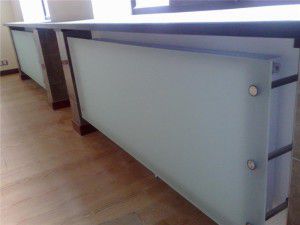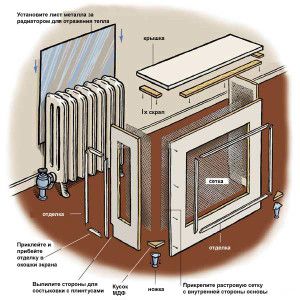Do you need screens for heating batteries? Alas, many do not even think about the possibilities of these components of heat supply. With the right approach to the configuration of the system, the grilles can not only improve the appearance, but also indirectly affect the parameters of heat supply. Therefore, experts recommend dealing with the features of decorative screens on batteries and heating radiators.
Purpose of decorative screens
The main task that protective shields for heating radiators successfully perform is to adapt the heat supply in the interior of the room. Often the appearance of radiators does not suit the owners of a house or apartment. In this case, the only way out is the hinged screen on the heating battery.
However, in addition to this function, decorative elements perform a number of other equally important ones. The design feature of modern batteries is a complex configuration that ensures optimal circulation of hot air.
But at the same time, the cleaning process is complicated - it is difficult to remove dust from their surface. In this case, the protective shields for the radiators will take on the main load. Removing dirt from their surface is much easier than using batteries.
In addition to these important features of operation, it should be noted such functional qualities that the hinged screen on the heating radiator fully possesses:
- Burn and injury protection. The surface of the battery can heat up to + 80 ° C. Contact with it in open areas of the skin may cause burns;
- Increase hot air convection. Even the simplest screen on a cast-iron heating battery will improve the distribution of hot flows. But for this, there must be gaps in its design through which air passes;
- Improving the appearance without replacing old radiators. Installed screens for wood heating radiators will help to hide obvious flaws - the appearance of smudges, rust spots, etc. It is important that they do not further affect the performance of the radiator.
One of the operating conditions for protective shields for radiators is the lack of influence on the system parameters. Those. they must have a sufficiently high thermal conductivity, but at the same time their surface can not be very hot. Therefore, all screens for heating radiators are made to order with special mounting elements that prevent full contact of the design with the battery.
Self-painting of protective shields for heating radiators should only be carried out using special heat-resistant compounds. Otherwise, the original color of the structure will change, and an unpleasant odor will appear in the room.
Types of decorative screens on batteries
At the first stage, it is necessary to choose the design of the protective panel. It depends on the required degree of concealment of the surface of the battery or radiator. In most cases, the installation of glass screens for radiators is carried out only from the front.
The main indicator is the desired appearance of the screen. It should be harmoniously combined with all elements of the room. But at the same time, the functional properties of heat supply cannot be affected. That is why custom-made screens for radiators are often installed. The design configuration is preliminarily agreed upon, its manufacturing materials and operational properties are determined.The same applies to screens for self-made heating radiators.
In addition to these factors, the shape of the structure is taken into account. It can fully or partially close the battery:
- Hinged protective shield for radiators without cover. They are designed for installation on cast iron radiators. Installation on steel structures is also possible;
- Hinged with cover. It is used if the hinged screen on the heat supply radiator should partially hide the upper part of the battery protruding from behind the window sill;
- Box. It is simply attached to a heating element without rigid fastening. Such designs are typical for wood heating panels or MDF screens. Differ in a possibility of fast dismantle;
- Flat screens. They are mounted in wall niches - under window structures. Glass screens for heat supply batteries have proven themselves best on the aesthetic and practical side.
After choosing a configuration, you need to consider the method of installation. One of the operating conditions of the protective panels for radiators is the possibility of quick dismantling. Therefore, most often they use mounted models that are installed directly on the battery. Rigid wall mounting is another installation method. However, this should ensure full access to all elements of the radiator.
The installation of curtain screens on radiators is one of the methods of protection when arranging heat supply in public buildings - schools, hospitals. Their installation in sports complexes and halls is also required.
Materials for the production of decorative screens
Often they tend to purchase ready-made decorative elements. Self-production of a curtain screen on a heating battery is a labor-intensive process that requires special tools and materials. Therefore, before buying, you need to understand the types of decorative heating components and determine their features.
The choice is determined by the configuration of the heat supply batteries. Not all models of screens for a cast-iron heating battery can be installed on bimetallic or aluminum radiators. Then you should measure the height and width of the structure.
The dimensions of the decorative element should be 3-5 mm larger than the received dimensions. But at the same time, after installing the hinged screen on the heating radiator, access to the temperature regulator, shut-off valves and Mayevsky tap is maintained.
An important point is the choice of material. Screens for heating radiators made of MDF look very good in almost any interior. But they can suffer from prolonged exposure to high temperatures. Consider the main types of materials for the manufacture of decorative panels:
- Metal. Currently, it is one of the most affordable types of building envelopes. Often they make metal screens for heating batteries with their own hands. It is only necessary to choose the right steel - it should not be afraid of corrosion. In this case, the best option would be stainless compounds or with a galvanized surface;
- Wooden. Since the tree can deform under prolonged temperature exposure, it is preferable to make screens for heating radiators from MDF. It also affects their value in the direction of reduction;
- Glass. This is the most exotic form of decorative elements. They are notable for their high cost, since for safety reasons glass screens for heating radiators are made of material with a large thickness - from 8 mm and more.
The determining parameter when choosing a material is the temperature mode of heating. After installation, the screen for wood heating batteries should not lose their external properties - change the configuration or shade.In the case of structures made of natural materials (MDF or wood), surface treatment with special compounds is necessarily performed. This fact must be taken into account when making a screen for a heating radiator with your own hands.
The use of plastic panels for decorating heating elements is not recommended. With a constant temperature difference, they can lose their appearance.
DIY decorative screen making
For self-production of a screen on a cast-iron heating battery, you need to determine its configuration and select the manufacturing material. Most often, special MDF models are used for this. This material is practical, inexpensive and has a long service life. It is precisely the poet who most often makes MDF screens for custom heating radiators.
At the first stage, you should measure the dimensions of the radiator. Height and width are measured. For the do-it-yourself radiator screen with side panels, it is necessary to determine the depth of the structure. Then, 10 cm in width and 5 cm in height are added to the data obtained. The depth of the future panel depends on the installation of the radiator. In the end, you can determine the dimensions of the future design.
The simplest method of self-manufacturing a screen for radiators is the production of a frame part on which a metal decorative mesh will be installed. To do this, you will need to purchase MDF, mesh and decorative strips for finishing the surface of the panel.
Stages of manufacturing a screen for heating radiators from MDF:
- According to the compiled design drawing, blanks are made. Pipe openings are cut out on the side panels. The presence of a temperature controller is also taken into account.
- Installation on the front of the screen steel mesh.
- To connect the front, side and top panels, you can use wooden blocks. Fastening is carried out using nails and special heat-resistant glue.
- The panel mounting locations are hidden using decorative strips.
The fabricated model is not necessarily rigidly attached to the wall. Most often, it is simply attached to the battery, and can be quickly removed if necessary.
If none of the types of screens is suitable for the interior of the room, you can consider purchasing a decorative radiator. But such models differ not only in their unique appearance, but also in high cost.
In the video material, you can familiarize yourself with the technology for manufacturing wooden screens for batteries:






